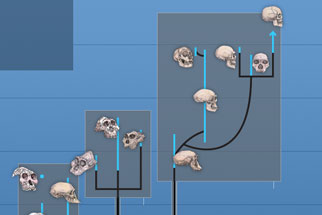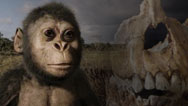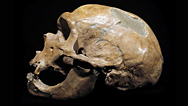Who's Who In Human Evolution
- By Peter Tyson
- Posted 11.01.08
- NOVA
Despite a fragmentary fossil record, paleoanthropologists have assembled a solid general picture of human evolution. They have traced hominins–that is, species that are bipedal and that are more closely related to humans than to other apes–back more than six million years. In this clickable illustration, follow the trajectory of hominin development from the earliest known species right up to our own kind, Homo sapiens.
 Launch Interactive
Printable Version
Launch Interactive
Printable Version
Meet your increasingly distant cousins in this clickable illustration of the past seven million years.
Note: The illustration, adapted with permission from the Smithsonian Intimate Guide to Human Origins by Carl Zimmer (Smithsonian Books, 2005, p. 41), does not include all hominin species that experts have proposed but rather offers a representative sample. Thanks to Daniel Lieberman, Professor of Biological Anthropology at Harvard University, for consultation on this feature.
Credits
Credits
- Design
- Tyler Howe
- Programming
- Alan Kwan
Images
- (diagram)
- from Smithsonian Intimate Guide to Human Origins by Carl Zimmer, HarperCollins Publishers, 2005. Used with permission from Madison Press Books.
Related Links
-

Becoming Human Part 1
First Steps: Six million years ago, what set our ancestors on the path from ape to human?
-

Are Neanderthals Human?
Neanderthals present a conundrum well known in biology: What exactly is a species?
-

Neanderthals: Expert Q&A
The leader of the team that proved we share DNA with Neanderthals answered questions about our closest relatives.
-

Are We Still Evolving?
Whether humans are still evolving biologically depends—and doesn't—on which humans you ask.
You need the Flash Player plug-in to view this content.

